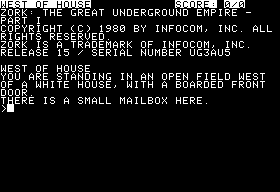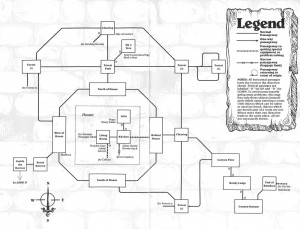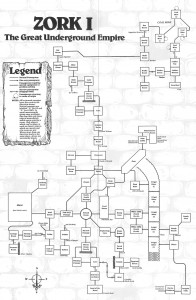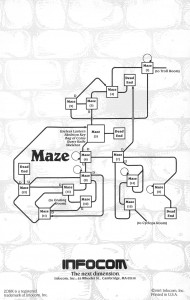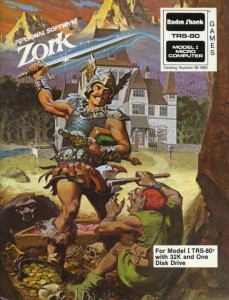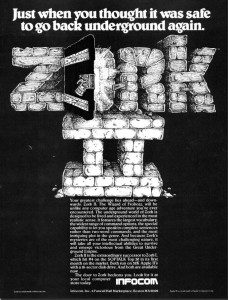I’ll be diving into Zork in some detail in my next post, but before I do that I just felt behooved to return in a bit more rigorous way to a subject I broached in my first post in this series: how impressive Zork was in the microcomputer world of 1980-81. I have a point I’m driving toward, one which involves a little bit of theory (uh oh!). But first let me set the stage with a few choice quotes from Jason Scott’s Get Lamp project.
“There were two products that sold more computers than anything else: VisiCalc and Zork.” — Mike Berlyn
“We would go after school to this store and play whatever games were available, type games in, and I remember Zork coming out and playing it on an Apple II, and we were just completely blown away.” — Andrew Kaluzniacki
“People would see Zork and say, ‘I gotta have me one of them, that’s all. Who do I make the check out to?'” — Mike Berlyn
“I think there was a time period, probably ’80 to ’84 sort of range, where, for a lot of the machines, compared to anything else out there, there was just nothing that compared.” — Mike Dornbrook
Yes, Berlyn’s placing Zork on a pedestal with the industry-defining VisiCalc is a bit over the top, but you get the picture. Statements like these read as ironic and maybe even a bit tragic today. Within a few years after Dornbrook’s 1980 to 1984 timeline, interactive-fiction publishers and fans would be lamenting IF’s lack of immediate, obvious appeal as the main reason for the genre’s declining commercial fortunes, amidst plenty of griping about the adolescent illiteracy of the typical videogame demographic and the like.
So, what did those early players find so immediately appealing about Zork? Certainly its world was not only bigger but modeled in a more rigorous, sophisticated way than anything that had come before. Certainly its writing, while often necessarily terse due to space constraints, showed a wit and nuance and, well, attention to basic grammar and spelling that eluded its competition. And certainly its design was, if still beset by infuriating mazes and some more-than-dodgy puzzles, also fairer than the norm. But these are things that text-adventure afficionados notice, the sort of things that only become clear after spending a few hours with Zork and (at least) a few hours with other games of its period. As the quotes above illustrate, people were playing Zork for a few minutes in shops and buying it in awe — and perhaps, Berlyn’s hyperbole aside, sometimes also buying the Apple II system they needed to play it. Why? I think the answer is bound up with the adventure game’s love-hate relationship with the parser.
In Joysprick, a book about James Joyce, Anthony Burgess divides authors into two fundamental categories. (Feel free to insert your own “two types of…” joke here; I’ll wait. Ready? Okay…) Class One authors are concerned exclusively with the storyworld — the virtual reality, if you will — that lives “beneath” their words. “Content being more important than style, the referents ache to be free of their words and to be presented directly as sense data.” “Good” writing, under this rubric, is writing that exists solely to serve the setting and the story it reveals, that evokes them as vividly as possible but that also gets out of the way of the reader’s imaginative recreation of the underlying virtual reality by diligently refusing to call attention to itself. Class Two authors, meanwhile, are concerned about their language as a end unto itself. Their books are “made out of words as much as character.” Sometimes, as in the case of Finnegans Wake or the “Siren” chapter of Ulysses, language seems like all there is — the writing is all “surface.” Some might say that being successful on this second level, or at least striving to be, separates “literature” from mere “fiction.” But let’s stay away from that can of worms. In fact, let’s try not to make any value judgments at all as we apply some of this to interactive fiction.
I don’t want to apply these ideas so much right now to the text that an IF game outputs to the player, but rather to the text that the player inputs — to the parser, in other words. One way to approach IF is as a rich virtual reality to be inhabited. In this view, that of the Class One player, the parser exists only as a conduit for her to inject her choices into that world, just as a Class One reader views the text as a window — hopefully as transparent as possible — through which she views the action in the storyworld. This has always been my basic approach to IF as a player and a writer. Since I seem to be indulging in a lot of direct quoting in this post anyway, let me get a bit pretentious and quote an earlier version of myself. I wrote the following as a comment on Mike Rubin’s blog back in 2008:
I think many people, myself included, did indeed play Facade as a comedy, trying ever more outrageous actions to see what happens, and, indeed, at some level trying to “break” the system. I would say, though, that when a player begins to do this it’s a sign that the game designer has failed at some level. I began to play Facade for laughs after trying several reasonable approaches and having the game respond either not at all or in a way that was clearly inappropriate to my actions. The mimesis broke down for me then and I began to treat the system as a clever toy rather than an immersive interactive narrative. There’s no shame in Facade’s failure, of course. It’s a revolutionary conception, and bound to need many more iterations before even approaching complete believability.
This does raise a point, though: I don’t think games can maintain their mimesis by scolding the player, telling her in no uncertain terms that she shalt NOT when she attempts to eat her sword or hit her friends. Rather, we should strive to make our writing so good and our environments so believable and our interactions so smooth that our player is drawn into our story, and it never occurs to her to eat her sword or hit her friends, any more than it would to her avatar. In other words, we must enable her to truly BECOME her avatar for the little while she plays.
As soon as the game starts to break down, so to speak, for the player… that’s when she remembers it’s just a silly text adventure, and that’s when she starts playing it for laughs and trying to break the system even further. I do it every year with at least a dozen of the Comp games, PURLOINING doors and buildings and generally running amok through the storyworld. Entertainment is where you find it, after all.
Some players will of course come to every game determined to break it. Some might find IF in general more interesting as a system to be played with than as a story, although I think other genres of gaming would scratch this particular itch much better. To those players, I say, fine, have your fun. However, I think most people who play IF do come to it wanting to be immersed and to experience a storyworld and, yes, a coherent story through someone else’s eyes for a while. The rewards of that must be far greater than those of trying random actions to see where the boundaries of the simulation are (entertaining as that can be).
(Did we say something about not making value judgements? I forget…)
Still, those folks who marveled at Zork in computer stores were not responding to it as a deep and immersive piece of fiction, nor even as a really sophisticated adventure game. Their awe was all bestowed at the level of the parser itself, as an object — a toy — unto itself. For all of the space restrictions they were laboring under, Infocom reserved room for witty rejoinders to the sort of crazy or nonsensical inputs people might walk up and enter in a computer store.
WEST OF HOUSE
YOU ARE STANDING IN AN OPEN FIELD WEST
OF A WHITE HOUSE, WITH A BOARDED FRONT
DOOR.
THERE IS A SMALL MAILBOX HERE.
>FUCK
SUCH LANGUAGE IN A HIGH-CLASS
ESTABLISHMENT LIKE THIS!
>SHIT
YOU OUGHT TO BE ASHAMED OF YOURSELF.
>TAKE ME
HOW ROMANTIC!
>ZORK
AT YOUR SERVICE!
>XYZZY
A HOLLOW VOICE SAYS 'CRETIN'.
>FIND HOUSE
IT'S RIGHT IN FRONT OF YOU. ARE YOU
BLIND OR SOMETHING?
>FIND HANDS
WITHIN SIX FEET OF YOUR HEAD, ASSUMING
YOU HAVEN'T LEFT THAT SOMEWHERE.
>FIND ME
YOU'RE AROUND HERE SOMEWHERE...
>CHOMP
I DON'T KNOW HOW TO DO THAT. I WIN IN
ALL CASES!
>WIN
NATURALLY!
>SIGH
YOU'LL HAVE TO SPEAK UP IF YOU EXPECT ME
TO HEAR YOU!
>REPENT
IT COULD VERY WELL BE TOO LATE!
>WHAT IS A GRUE?
THE GRUE IS A SINISTER, LURKING PRESENCE
IN THE DARK PLACES OF THE EARTH. ITS
FAVORITE DIET IS ADVENTURERS, BUT ITS
INSATIABLE APPETITE IS TEMPERED BY ITS
FEAR OF LIGHT. NO GRUE HAS EVER BEEN
SEEN BY THE LIGHT OF DAY, AND FEW HAVE
SURVIVED ITS FEARSOME JAWS TO TELL THE
TALE.
>WHAT IS A ZORKMID?
THE ZORKMID IS THE UNIT OF CURRENCY OF
THE GREAT UNDERGROUND EMPIRE.
>YELL
AAAARRRRGGGGHHHH!
This is playing Zork as Eliza: seeing what response this or that input gives, and of course probing for the limits. As some recent experiments have demonstrated, this mode of interaction is still pretty much the default when the uninitiated are confronted with a work of IF for the first time. Back in 1981, when computers were not so well understood and for most people still seemed vaguely magical (if not sinister), the idea of typing something, especially something off the subject or just plain inappropriate, and being understood was a much more powerful one, bringing to mind HAL and the Enterprise‘s talking computer.
All of which is apropos of… what? I’m not sure there are any grand lessons to take away here. After a pretty short while, toying with the parser and trying to break things loses its appeal, and the player either starts to engage with the storyworld and its fiction or just goes on to something else; thus the impatience I express above with players who just can’t seem to get past their triumph that, yes, they can break the parser and probably even the world simulation without too much effort. Over a decade after Zork, a graphical adventure called Myst became for some years the bestselling computer game of all time. It was often labeled the least-played bestseller ever. People bought it to show off their new graphics cards, sound cards, and CD-ROM drives in the midst of the “multimedia PC” boom of the early 1990s, but I’d be shocked if even ten percent seriously engaged with its intellectually intricate puzzles or made a real effort to finish it. Similarly, I suspect that plenty of copies of Zork existed more as something to pull out at cocktail parties than an abiding passion.
But let’s not start printing our “I appreciate Zork on a much deeper level than you” tee-shirts quite yet, because it’s also true that none of us ever wholly become Class One players. One more Get Lamp quote, this time from Bob Bates, captures some of the back and forth that forms a big part of the delights of the text adventure:
“A lot of games only program the ‘if,’ which is that main path I was talking about earlier. If the player does this and everything’s right, then you do this and the game goes on. But there’s always that ‘else.’ What if the player doesn’t do what you expected? What if he comes up with this weird idea or that strange input or that other, off-the-wall thing that he wants to try, just to see if the game breaks. Just to see where the edges are. That’s part of the fun of playing a text adventure, and that’s part of the fun — a great deal of the fun — that I had in creating them, in that imagined dialog with the player, so that at the end of the day when the player does this very weird thing, and he says, ‘Oh, nobody would ever think of trying this,’ he says, ‘Oh, my goodness! There’s a non-default response there! The author actually thought about that!’ That helps form that bond between you and the author. ‘That guy’s just as strange as I am. He and I think the same way.'”
So, a motto for text-adventure success: attract and charm them with your parser, retain them with your storyworld. In the spirit of the latter, we’ll put our Class One players’ hats on and venture into the Great Underground Empire next time. No, really, this time I promise.
